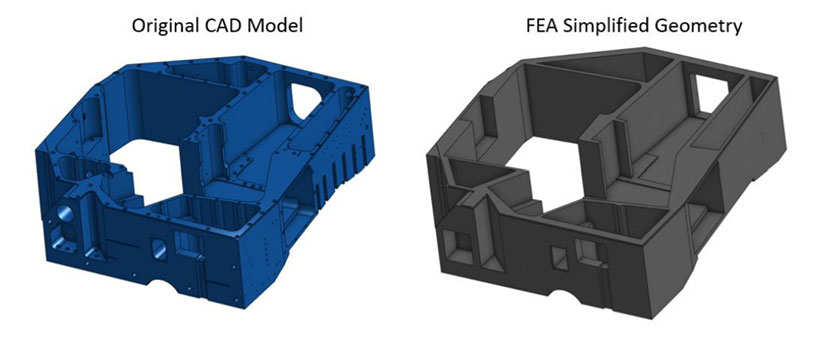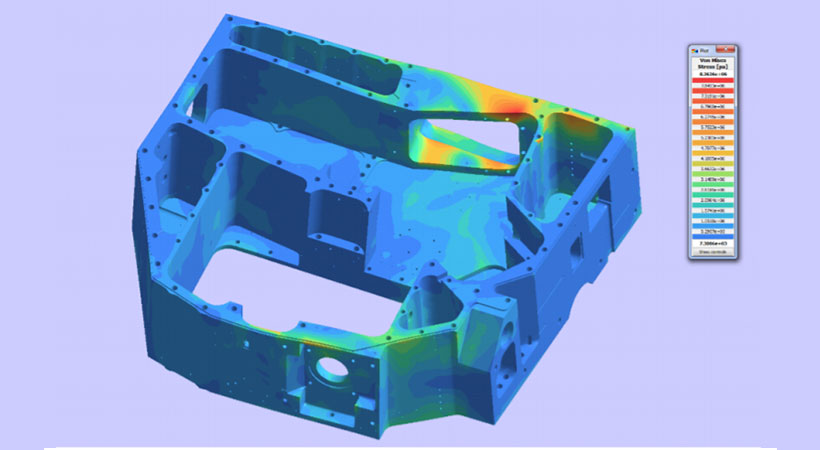Solving the Geometry Problem: Simulation-Driven Design
Over the years, computer-aided design (CAD) system geometry has evolved…from wireframes to surfaces to solids, and parametric to direct. Simulation, however, remains stuck using the same old beam, shell or simplified-solids paradigm invented more than 50 years ago. As CAD geometric completeness has grown, so has the effort to convert it into a simpler form suitable for meshing and analysis. The bottom line is that these “CAD to mesh” steps require many judgment calls, are labor-intensive and error-prone, and require experts in both simulation and CAD…until now.
Altair SimSolidTM was designed to work directly on fully featured CAD assemblies without creating a mesh. This allows you to quickly analyze original CAD geometry without modification or simplification, including multiple design iterations of large assemblies and complex parts that would not be considered practical with mainstream finite element analysis (FEA).
The Geometry Problem
The geometry of CAD and traditional FEA are different. CAD creates geometry to define design and manufacturing requirements, while FEA needs to transform this into a simplified form to define the mesh. This disparity between CAD and FEA geometry models needlessly complicates the analysis-user paradigm in many areas—some obvious, some subtle. The obvious complication is the need to dramatically simplify the geometry so that a mesh can be reliably created. Many decisions must be made as to which parts and part features can be removed without modifying the geometric design intent. This is a process that requires expertise and, naturally, different people will likely create different results.
The less-than-obvious complication involves small tweaks to geometry often required to get the traditional FEA mesh generator to create adequate-shaped elements, or the special elements and special mesh transitions required to create connections between parts—bolts, welds, etc.
The geometry problem is the primary inhibitor blocking wider adoption of simulation in design workflows. Incremental user interface improvement in geometry and meshing is not the solution. A fundamental process change is required.
Here is an example of the original CAD geometry and one possible simplification used in traditional FEA.

With SimSolid, all features are left in the model and the full fidelity geometry is used in the analysis. This geometry is a complex single part of 1,200+ faces and 150+ small holes. Solution time including model setup is less than four minutes, and reanalysis is fast—less than one minute.

The Altair SimSolid Solution
SimSolid solves the geometry problem by replacing the underlying core FEA solution technology. The implementation of analysis in the design process means the analysis results are used to make design decisions. It is, therefore, important the analysis tools provide results with predictable accuracy.
Here are some important attributes of the SimSolid solution that positively impacts the simulation driven design approach:
SimSolid is often met with serious skepticism. While we certainly understand this standpoint, SimSolid has been extensively tested by both Altair and outside companies/users in a variety of industries. One such third party user, Dr. Richard King, spent extensive time producing an extremely detailed validation manual with Altair SimSolid. If you want to see the proof for yourself, you can download the guide completely free by clicking here.
 Simulation comparison and correlation of an extremely detailed golf driver head in Altair SimSolid and Altair OptiStruct
Simulation comparison and correlation of an extremely detailed golf driver head in Altair SimSolid and Altair OptiStruct
Conclusion
For simulation to truly drive the design process, it needs to work in step with each geometric concept and modification. Simulation working directly on design geometry provides a path to quick, meaningful answers that can guide designers and engineers to more optimal design scenarios. SimSolid is the only technology to provide this.
Still not convinced? Try SimSolid for yourself. We think you will agree that it is how design simulation should be done.
Finally, let’s have a little fun. Click here to complete our three-minute “SimSolid Time Trial Challenge” to see if you can guess just how fast SimSolid really is and be entered for a chance to win a $50 gift card!
Altair SimSolidTM was designed to work directly on fully featured CAD assemblies without creating a mesh. This allows you to quickly analyze original CAD geometry without modification or simplification, including multiple design iterations of large assemblies and complex parts that would not be considered practical with mainstream finite element analysis (FEA).
The Geometry Problem
The geometry of CAD and traditional FEA are different. CAD creates geometry to define design and manufacturing requirements, while FEA needs to transform this into a simplified form to define the mesh. This disparity between CAD and FEA geometry models needlessly complicates the analysis-user paradigm in many areas—some obvious, some subtle. The obvious complication is the need to dramatically simplify the geometry so that a mesh can be reliably created. Many decisions must be made as to which parts and part features can be removed without modifying the geometric design intent. This is a process that requires expertise and, naturally, different people will likely create different results.
The less-than-obvious complication involves small tweaks to geometry often required to get the traditional FEA mesh generator to create adequate-shaped elements, or the special elements and special mesh transitions required to create connections between parts—bolts, welds, etc.
The geometry problem is the primary inhibitor blocking wider adoption of simulation in design workflows. Incremental user interface improvement in geometry and meshing is not the solution. A fundamental process change is required.
Here is an example of the original CAD geometry and one possible simplification used in traditional FEA.

With SimSolid, all features are left in the model and the full fidelity geometry is used in the analysis. This geometry is a complex single part of 1,200+ faces and 150+ small holes. Solution time including model setup is less than four minutes, and reanalysis is fast—less than one minute.

The Altair SimSolid Solution
SimSolid solves the geometry problem by replacing the underlying core FEA solution technology. The implementation of analysis in the design process means the analysis results are used to make design decisions. It is, therefore, important the analysis tools provide results with predictable accuracy.
Here are some important attributes of the SimSolid solution that positively impacts the simulation driven design approach:
- Fast and efficient – SimSolid provides superior performance metrics for computational time and memory footprints and allows very large and / or complex assemblies to be solved quickly on desktop-class PCs. It also directly analyzes fully featured CAD assemblies. Time-consuming model simplification techniques, such as defeaturing and mid-surfacing, are not required.
- Accurate – SimSolid controls solution accuracy using multi-pass adaptive analysis. Adaptivity can be defined on a global or part-local basis, and adaptivity is always active.
- User-friendly – SimSolid is simple enough to be used without the need for extensive training and monitoring.
- No mesh needed – There is never a user requirement to create a mesh.
SimSolid is often met with serious skepticism. While we certainly understand this standpoint, SimSolid has been extensively tested by both Altair and outside companies/users in a variety of industries. One such third party user, Dr. Richard King, spent extensive time producing an extremely detailed validation manual with Altair SimSolid. If you want to see the proof for yourself, you can download the guide completely free by clicking here.
 Simulation comparison and correlation of an extremely detailed golf driver head in Altair SimSolid and Altair OptiStruct
Simulation comparison and correlation of an extremely detailed golf driver head in Altair SimSolid and Altair OptiStructConclusion
For simulation to truly drive the design process, it needs to work in step with each geometric concept and modification. Simulation working directly on design geometry provides a path to quick, meaningful answers that can guide designers and engineers to more optimal design scenarios. SimSolid is the only technology to provide this.
Still not convinced? Try SimSolid for yourself. We think you will agree that it is how design simulation should be done.
Finally, let’s have a little fun. Click here to complete our three-minute “SimSolid Time Trial Challenge” to see if you can guess just how fast SimSolid really is and be entered for a chance to win a $50 gift card!




